Endangered Species/Wildlife Income Tax Check-Off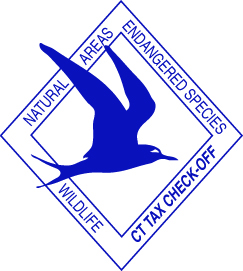
The "Endangered Species/Wildlife Income Tax Check-Off Fund" is a fund that was created in 1993 by the legislature to allow Connecticut state income taxpayers to voluntarily donate portions of their tax refund to support efforts aimed at helping Connecticut's endangered species, natural area preserves, and watchable wildlife. Citizens can also contribute directly by sending a check payable to "DEEP-Endangered Species/Wildlife Fund" to:
Department of Energy and Environmental Protection
Bureau of Financial and Support Services
79 Elm Street, Hartford, CT 06106-5127
Since the inception of the Tax Check-off Program, a number of projects have been funded in the areas of habitat restoration, inventory, monitoring, and education. The following projects represent some that have been totally or partially funded by the Connecticut "Endangered Species/Wildlife Income Tax Check-off Fund."
Endangered Species/Wildlife Income Tax Check-off Fund Projects
Mammals
Bats Count! Bat Cam: The CT DEEP Wildlife Division and White Memorial Conservation Center in Litchfield are working together to establish a series of Bat Cams in a barn at White Memorial where female big brown bats give birth to and raise their young every year. The Bat Cam is an important monitoring tool that will give biologists a window into the life and activities of an active big brown bat maternity colony, while also providing the opportunity for students and others to follow along and learn about this amazing species. Learn more about this exciting new project for 2023!
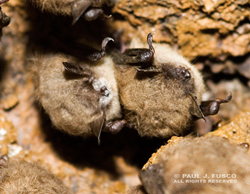
Acoustic Bat Monitoring on State Lands: Since 2006, white-nose syndrome (WNS), a fungal disease, has devastated bat populations throughout North America. It was first documented in Connecticut in the winter of 2008, and has caused precipitous declines in what were once some of our most common bats. As a result, some of these species are now protected under the state and federal Endangered Species Acts. To determine where in Connecticut these bats still occur, acoustic surveys are conducted statewide with a focus on state forests. This information will help guide forest management and bat conservation efforts and ensure that these unique animals remain an important part of Connecticut’s ecosystem.
Bat Hibernacula Protection: This project involved the study and protection of one of Connecticut's largest known bat hibernaculas. There had been concern that trespassers and vandalism at the site posed a risk to the hibernating bats. The project identified critical areas being used by bats and improved the gating system at the site with bat-friendly gates. This allows bats free access to the old mine shafts used as wintering sites, but keeps trespassers out. The project was a cooperative effort of the landowner, DEEP, the U.S. Fish and Wildlife Service, Bat Conservation International, and the U.S. Department of Agriculture Natural Resource Conservation Service.
Bat Survey: This project involves winter surveys of known winter bat hibernaculas and includes summer mist netting surveys which study the distribution of Connecticut's native bats.
Bat Telemetry - Roost Location Survey: Three tree-roosting bat species -- the red, hoary, and silver-haired -- are seldom encountered by people and little is known about their population status, their Connecticut distribution, or preferred habitat. This project was designed to identify specific habitat requirements of these state-listed, special concern species so they can be better managed. This project was also partly funded by a federal Partnerships for Wildlife grant.
New England Cottontails: This project involved a population and habitat study of the New England cottontail, which is Connecticut’s only native rabbit species. This project provided DEEP with current data on the relative abundance and distribution of New England cottontails to determine its status under the state and federal endangered species act.
Least Shrew Inventory and Habitat Assessment: A marsh complex in coastal Connecticut is the only documented location of the state-endangered least shrew. To better manage this marsh for the shrew, studies were conducted to document how extensive least shrew habitat is within the marsh and to evaluate such use in relation to potential marsh restoration projects in the future.
Birds
 Monitoring Ospreys Using Citizen Science: After experiencing historic lows in the early 1970s, Connecticut’s osprey population has made a dramatic comeback following the ban of the pesticide DDT. The number of nests has increased into the hundreds across the state. Documenting and monitoring these nests would be impossible without the help of volunteer nest monitors and Osprey Nation, a community science project launched by the Connecticut Audubon Society in partnership with the DEEP Wildlife Division in 2014 to catalog and collect information about the state’s nesting ospreys. This project will provide resources to continue to coordinate volunteers and compile observations.
Monitoring Ospreys Using Citizen Science: After experiencing historic lows in the early 1970s, Connecticut’s osprey population has made a dramatic comeback following the ban of the pesticide DDT. The number of nests has increased into the hundreds across the state. Documenting and monitoring these nests would be impossible without the help of volunteer nest monitors and Osprey Nation, a community science project launched by the Connecticut Audubon Society in partnership with the DEEP Wildlife Division in 2014 to catalog and collect information about the state’s nesting ospreys. This project will provide resources to continue to coordinate volunteers and compile observations.
Preservation of an Important Chimney Swift Roost: This project targeted conservation of the chimney swift, a greatest conservation need bird species that travels 3,000 miles each year to nest in Connecticut buildings each summer. Every year, over a half a million chimney swifts disappear across their range. Vital habitat components are large chimneys, in which hundreds of swifts congregate to roost overnight. The chimney at the Grove Manor Apartment building in Thomaston is among the largest of the known chimney swift roosts in Connecticut and has been used for shelter by over 300 swifts at any one night for at least the past 10 years. Because the chimney was no longer used as part of the building heating system, the town of Thomaston partnered with the Wildlife Division to fund the necessary renovations to preserve the chimney structure. Funds for this project also provide safe and easy access to conduct research and monitoring of the roosting birds.
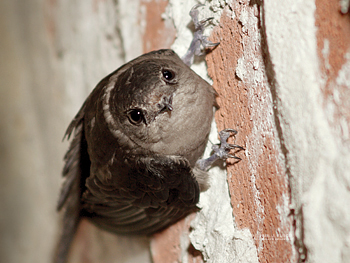
Photo credit: Paul J. Fusco/Mount Vernon Songbird Sanctuary
Estimation of Seasonal Survival Rates in Chimney Swifts: This project targeted conservation of the chimney swift, a greatest conservation need bird species that inhabits homes and buildings each summer across Connecticut. Every year, over a half a million chimney swifts disappear across their range. This precipitous decline can only be halted if we know what factors are limiting these birds, and at what stage in their life cycle. This work will answer the question of whether survival is being impacted on the breeding grounds or the wintering grounds. Once information is gathered, it will be critical towards developing meaningful conservation actions to reverse the current downward trend.
Grassland Bird Management Plan at Bradley International Airport: Funding was provided to develop a comprehensive management plan for grassland bird habitat at Bradley International Airport. Management recommendations will assist airport officials in planning future facilities and implementing the best practices to conserve important nesting sites.
Least Tern Recovery: The least tern is listed as a threatened species in Connecticut. The proximity of least tern nesting colonies to high human use areas results in increased disturbance to nesting birds, which may significantly affect overall productivity. Project efforts focus on studying reproductive success, habitat management, and protection.
Barn Owl Management: A barn owl nest box project was initiated to provide this state-threatened species with available nesting sites in suitable habitats. Nest boxes have been installed on public and private lands. Volunteers have been monitoring boxes to assess owl populations.
Heron/Egret Rookery Protection: Offshore islands in Long Island Sound, where several state-listed herons and egrets nest, are subject to various types of disturbance. Monies were used for the protective fencing of island rookeries and the posting of educational signs that detail natural history information and explain current conservation concerns and management strategies for these species. Monies were also used to develop a plan for the management and protection of heron and egret populations in Connecticut.
Ospreys: Osprey productivity at Great Island Wildlife Management Area had declined considerably during the mid-1990s. Research efforts focused on identifying possible limiting factors to nest success. Funds were also used to assess possible contamination of unhatched osprey eggs. Contaminants in the form of heavy metals, pesticides and PCBs, among others, can pose serious threats to wildlife populations.
Study of the Effect of Timber Harvesting on Blue-winged Warblers and Other Shrubland Bird Species: The goal is to determine the habitat requirements of blue-winged warblers and other shrubland bird species and to analyze the importance of the height, density, and composition of the vegetation, and also the size, shape and configuration of clearcuts. This information will be useful for developing forest cutting plans that enhance the habitat for shrubland nesting birds. Connecticut College is a partner on this project.
Wetland Bird Call-Response Survey: Funding helped administer and coordinate a volunteer project to survey the occurrence of several state-listed wetland dependent bird species. DEEP personnel and volunteers use tape recorded bird calls to elicit vocalizations by secretive wetland birds at sites throughout Connecticut. Surveys of current and historic state-listed wetland bird habitats have been conducted in Connecticut since 1993. The use of volunteers allows DEEP to collect data from a much larger area than could be sampled by Wildlife Division staff alone.
Inventory of Worm-eating Warblers: Worm-eating warblers have been identified as a priority species of conservation concern in southern New England. This project was initiated to develop techniques to more thoroughly assess the status of worm-eating warblers in Connecticut and to learn about their habitat requirements in this portion of their range.
Reptiles and Amphibians
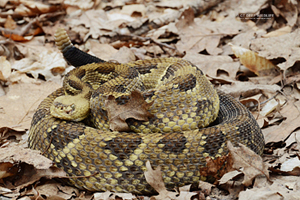 Snake Fungal Disease: In recent years, a fungal disease, which causes lesions and may also lead to facial deformities and sometimes death, has shown up in snake populations across the Midwest and eastern United States. Although the severity and distribution of this fungal disease in Connecticut remains unknown, at least two species – the timber rattlesnake and eastern milk snake – have been documented with fatal infections. This study, implemented by DEEP, aims to collect data on snake fungal disease to provide a clearer picture of its statewide distribution, rate of occurrence, and severity across the state.
Snake Fungal Disease: In recent years, a fungal disease, which causes lesions and may also lead to facial deformities and sometimes death, has shown up in snake populations across the Midwest and eastern United States. Although the severity and distribution of this fungal disease in Connecticut remains unknown, at least two species – the timber rattlesnake and eastern milk snake – have been documented with fatal infections. This study, implemented by DEEP, aims to collect data on snake fungal disease to provide a clearer picture of its statewide distribution, rate of occurrence, and severity across the state.
Assessment of Heavy Metal and Organic Contaminants in Snapping Turtles: Snapping turtles are a long-lived and poorly understood species in Connecticut. Heavy metal and organic contaminants that build up over time in these aquatic turtles can have dramatic effects on their reproductive success. This study provides a better understanding of the current types and amounts of contaminants in snapping turtles and also helps biologists understand the biological effects of these contaminants in wildlife populations. Information from the study will be essential to ensuring that this iconic reptile remains part of Connecticut’s wildlife heritage.
Stream Salamanders Living within Exurban* Watersheds: Small mammals, amphibians, and many other kinds of wildlife that live in woodlands are often displaced or experience high mortality rates when those areas are developed for new homes. Over time, the forest regrows and populations may rebound; however, habitat quality may slowly decline. This project examines the impacts of these habitat changes and the ability of stream salamanders to persist over time. Information obtained from this project will help with future management and land-use decisions.
*Exurban is a semirural region lying just beyond the suburbs of a city.
Wood Turtle Study: The wood turtle is a species of special concern in Connecticut. Its population is in serious decline in developed parts of the state and this study focuses on determining the population status in and around Natchaug State Forest. The project involved the use of radio tags to monitor movement and location of wood turtles during different seasons. Summer field assistance for this project involved students and teachers from EASTCONN and other local schools.
Amphibian Monitoring Volunteer Project: This project involved providing equipment and training materials for volunteer field assistants in the Connecticut Amphibian Monitoring Project (CAMP). The goal of CAMP is the long-term monitoring of amphibian species diversity in Connecticut. This long-term monitoring provides baseline data for amphibian species and may detect long-term changes in their diversity. Protocols include frog call surveys, and night road searches during spring, summer, and fall. Volunteers in CAMP received detailed instruction and survey material. CAMP data is provided to state, federal, and private agencies involved in conservation.
Rattlesnake Population Assessment: The state-endangered timber rattlesnake was studied through spring, summer, and fall surveys and through extensive research focusing on their historic distribution in Connecticut. An evaluation of current threats and recommendations for protection were provided to better manage this imperiled reptile.
Black Racer Survey: This project to study movement patterns and habitat use of the black racer snake involved marking, recapturing, and radio-tracking individuals during their active season. Results provided researchers with specific habitat requirements of the black racer.
Bog Turtle: Funding was provided for the development of a plan to protect and conserve the state endangered and federally threatened bog turtle.
Plants
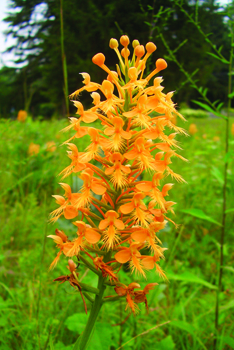 State-Listed Plant Field Work: Connecticut’s Endangered, Threatened and Special Concern Species List includes 331 plants. Botanical field work was conducted with emphasis on locating new populations of state-listed plant species and updating known locations of priority species. All populations of state-listed plant species that were found during the field work were documented with photos and reporting forms, and submitted to DEEP’s Natural Diversity Data Base. This information is critically important to the process of updating the state Endangered Species List. It also is used in the evaluation of property reviews for state land acquisition and in the environmental permit review process.
State-Listed Plant Field Work: Connecticut’s Endangered, Threatened and Special Concern Species List includes 331 plants. Botanical field work was conducted with emphasis on locating new populations of state-listed plant species and updating known locations of priority species. All populations of state-listed plant species that were found during the field work were documented with photos and reporting forms, and submitted to DEEP’s Natural Diversity Data Base. This information is critically important to the process of updating the state Endangered Species List. It also is used in the evaluation of property reviews for state land acquisition and in the environmental permit review process.
Botanical Field Work: Botanical field work was conducted to collect data on plant species listed as endangered, threatened, or special concern in Connecticut. A critical part of Connecticut’s Endangered Species Program is monitoring the status of known populations, documenting new occurrences, and evaluating the need for management to protect or enhance these populations. This information also is used to update DEEP’s Natural Diversity Data Base (NDDB), which assists in conducting environmental reviews and updating the state’s Endangered Species List.
Botanical Field Work: Connecticut’s Endangered Species List includes 335 plants. A critical part of the Endangered Species Program is monitoring the status of known populations, locating new ones, and evaluating the need for management to protect or enhance these populations. This information is used to update DEEP’s Natural Diversity Data Base, which assists in conducting environmental reviews and updating the Endangered Species List.
Herbarium Research on Candidate Plant Species: In 1996, the major New England herbaria were visited to obtain information about 63 species of plants that occur in Connecticut. A herbarium is a museum collection of dried plant specimens, mounted and labeled for scientific study. Location information recorded on voucher specimen labels assisted DEEP in determining the status of species that are believed to be regionally rare and assisted in the 1997 re-evaluation of the State Endangered Species List.
Mapping of State-listed Candidate Species - Plants: Information on 39 candidate plant species has been incorporated onto the hard copy reference maps, the Geographic Information Systems coverages of listed species, and the manual files of listed species maintained by the Natural Diversity Data Base.
Bluff Point Coastal Reserve Vegetative Study: DEEP staff and Connecticut College students conducted inventories documenting baseline conditions of vegetation within Bluff Point Coastal Reserve. The information will be used to document vegetative changes in herbaceous cover species, seedlings, and shrubs over time and to identify both impacts and the recovery of state-listed species within the Reserve.
Statewide Botanical Field Surveys: Botanical field surveys were undertaken to assess the status of historic populations of state endangered, threatened, and special concern plant species and provide information about size and extent of population, reproduction, and potential threats. Many new populations of state-listed plants were located during these surveys. This information is used to update DEEP's Natural Diversity Data Base and to assist land protection efforts throughout the state.
Botanical Field Surveys: This project involved conducting botanical field surveys, updating historic records, and locating new populations of state-listed endangered, threatened, and special concern plant species. Locations and status of populations will be integrated into the Natural Diversity Data Base and made available to a variety of users.
Invertebrates
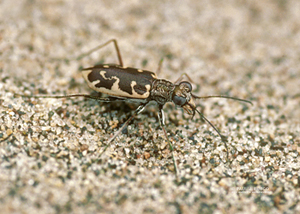 Restoration of Puritan Tiger Beetle Habitat on the Connecticut River: The Puritan tiger beetle (Cicindela puritana) is a critically imperiled species that occurs in two places in the world; along the Connecticut River in Connecticut and Massachusetts and along the Chesapeake Bay in Maryland. Connecticut has the strong-hold of this population in the Northeast. To ensure the long-term survival of this intriguing animal, its habitats require maintenance and, in some cases, restoration. Vegetation management to enhance sandy river beaches in Connecticut is needed to ensure that adequate habitat is available for this federally threatened and state endangered species.
Restoration of Puritan Tiger Beetle Habitat on the Connecticut River: The Puritan tiger beetle (Cicindela puritana) is a critically imperiled species that occurs in two places in the world; along the Connecticut River in Connecticut and Massachusetts and along the Chesapeake Bay in Maryland. Connecticut has the strong-hold of this population in the Northeast. To ensure the long-term survival of this intriguing animal, its habitats require maintenance and, in some cases, restoration. Vegetation management to enhance sandy river beaches in Connecticut is needed to ensure that adequate habitat is available for this federally threatened and state endangered species.
Restoration of Ghost Dune Tiger Beetle Habitat at Matianuck Natural Area Preserve: Since 1984, the Matianuck Sand Dunes have been recognized by DEEP as a unique ecological community worth protecting. Matianuck Natural Area Preserve (NAP) is one of two places in Connecticut where the ghost dune tiger beetle (Cicindela lepida) has been documented. Currently, forest succession threatens the quality of this unique community. Given both the rarity of this tiger beetle and the increasing scarcity of its required habitat, forest management along the periphery of the dunes at Matianuck NAP is essential to prevent the extirpation of the ghost dune tiger beetle from Connecticut.
Dragonfly/Damselfly Project: Color illustrations were prepared and distribution data were collected for the dragonflies and damselflies in Connecticut. This information was used for the production of an atlas documenting the 148 species which occur in Connecticut.
Banded Bog Skimmer: The banded bog skimmer, a state endangered dragonfly, was the focus of an intensive survey for invertebrates in eastern Connecticut. To add to the survey's success, the state endangered racket-tailed emerald butterfly also was observed.
Connecticut Tiger Beetle Status Survey: Field surveys were conducted to determine the current distribution and population status of tiger beetles in Connecticut. Resulting information will contribute to tiger beetle conservation in the state and will also be incorporated into an existing website that includes an identification key to the species.
Dragonflies/Damselfies: The goal of this project was to develop a dynamic website that promotes the interest in and understanding of Connecticut’s dragonflies/damselflies. The site will feature species accounts, species checklists, illustrations, and thumbnail images with links to high resolution images. The site will engage users from beginner to entomologist level and will encourage active participation in "fly watching."
Fish
Bridle Shiner Conservation Genetics: Statewide Genetic Diversity: Populations of bridle shiner (Notropis bifrenatus), a state special concern fish species, have experienced substantial declines since the 1960s. To inform management and conservation of bridle shiner, DEEP and the University of Connecticut proposed a research effort to evaluate the genetic diversity of this species across the state. This research provides a valuable first step toward developing conservation strategies for bridle shiner.
Shortnose Sturgeon Assessment: The shortnose sturgeon, a state and federally endangered fish species, appears to have two breeding populations in the Connecticut River. To understand the habits and needs of the species, juvenile sturgeon were captured and tagged, using radio transmitters.
Distribution and Habitat Characteristics of the Banded Sunfish: This species is listed as threatened in Connecticut. Additional research is needed to accurately assess the distribution and abundance of this species in Connecticut.
Shortnose Sturgeon Food habits in the Connecticut River: The goal of this project was to aid in identifying limiting factors and critical habitat requirements for the shortnose sturgeon in the Connecticut River. Data collected on food habits and prey preferences are required to aid in determining if prey availability may be one of the limiting factors affecting population numbers of this state and federally endangered species in Connecticut.
Natural Area Preserves
Pachaug and Mount Misery Natural Area Preserve: During the 1999 field season, information on vegetation patterns and presence of state-listed plant species was collected at these two preserves. Vegetation maps were produced and serve as the basis for the development of a management plan and as a guide for future vegetative studies.
Robbins Swamp Natural Area Preserve: Robbins Swamp, which is the state's largest inland wetland, contains many state-listed species and is an important wildlife management area. Funding provided for the development of a plan that details the purpose, character, and protected resources within the Preserve. The plan details management measures that will protect and enhance the Preserve's physical and biological integrity.
Kitchell Wildlife Sanctuary Vegetation and Botanical Surveys: This Preserve has long been managed as a wildlife sanctuary and its woodlands protected for certain passive recreational uses. A comprehensive survey of its vegetation has produced a vegetation cover type map that also documents locations of state-listed species. This map serves as a guide for future biological studies and the development of a management plan for the site.
Hopeville Pond Natural Area Preserve: A one-year "baseline" inventory of the invertebrate fauna was conducted in 1996. This study generated essential data on invertebrates occurring at Hopeville Pond Natural Area. Breeding bird surveys were conducted during June 1996. Thirty-nine species of birds were observed or heard in this area with at least 23 species believed to be breeding on the site. These data were useful in preparing a management plan for the site.
Canaan Mountain Natural Area Preserve Vegetation and Botanical Surveys: During the growing season of 1997, baseline information about existing vegetation and plant species of the Canaan Mountain Natural Area Preserve was compiled for the purpose of developing a management plan for the area.
Higganum Meadows Wildlife Area Avian Study: The purpose of this project was to perform a study of the Natural Area Preserve, which features upland, wetland, and riverine communities containing state endangered plant and animal species. A clearer understanding of the year-round avian use of the site aided development of management plans and the direction of ongoing management efforts.
Matianuck State Park and Natural Area Preserve Invertebrate Study: Preliminary surveys revealed that open sand patches host a remarkable insect community, including significant finds of the big sand tiger beetle and ghost dune tiger beetle. Other invertebrates surveyed included beetles, flies, wasps, bees, and other sand-dwellers.
Education and Recreation
 Installation of Monofilament Fishing Line Receptacles: In 2008, tax check-off funding was used by DEEP to construct and install monofilament fishing line recycling receptacles at several popular fishing locations and boat launches. Since then, monofilament line has been recovered from every receptacle by volunteer monitors and the waste line was sent to a company for recycling. The success of these receptacles prompted a number of conservation groups to put up and monitor their own at additional areas. DEEP continues to receive inquiries about putting up more receptacles, so this project is an extension of the original effort. To continue to heighten public awareness about the negative impacts of fishing line debris on aquatic life, especially birds (gulls, osprey, etc.), this project will provide educational signs detailing these hazards and more receptacles to lessen the amount of waste line that enters the environment. The receptacles will be installed at select boat launches and fishing areas where stewards and volunteers are able to monitor and maintain them. Line will be disposed of by shipping it to a recycling center. (Find out where receptacles are located)
Installation of Monofilament Fishing Line Receptacles: In 2008, tax check-off funding was used by DEEP to construct and install monofilament fishing line recycling receptacles at several popular fishing locations and boat launches. Since then, monofilament line has been recovered from every receptacle by volunteer monitors and the waste line was sent to a company for recycling. The success of these receptacles prompted a number of conservation groups to put up and monitor their own at additional areas. DEEP continues to receive inquiries about putting up more receptacles, so this project is an extension of the original effort. To continue to heighten public awareness about the negative impacts of fishing line debris on aquatic life, especially birds (gulls, osprey, etc.), this project will provide educational signs detailing these hazards and more receptacles to lessen the amount of waste line that enters the environment. The receptacles will be installed at select boat launches and fishing areas where stewards and volunteers are able to monitor and maintain them. Line will be disposed of by shipping it to a recycling center. (Find out where receptacles are located)
Conservation and Stewardship of State Endangered and Threatened Species: Connecticut’s Endangered, Threatened and Special Concern Species List includes large, charismatic animals like the bald eagle and more elusive ones like the timber rattlesnake, both of which can engage public interest. However, because the bald eagle and timber rattlesnake are sensitive to human disturbance, this interest sometimes leads to intrusion at nest and den sites that can be detrimental to the conservation and recovery of these listed species. This project involves the use of video and still photos to help limit illegal collection of rattlesnakes and disturbances to both bald eagles and rattlesnakes. Cameras were installed at certain bald eagle nests and rattlesnake dens so that DEEP staff can monitor and evaluate the degree of any threats, enforce laws, and engage public outreach. Footage obtained from the cameras will be shared with the public so that they can safely watch the animals without causing disturbance. It is anticipated that being able to observe bald eagles and rattlesnakes up-close through photos and video will foster a sense of stewardship critical to wildlife conservation.
Printing of the 1997 Updated List of Connecticut's Endangered, Threatened and Special Concern Species: Funds were used to publish an informational brochure describing the results of the five-year review and update to the state's endangered, threatened and special concern species list.
Endangered Species/Wildlife Income Tax Check-Off Program PSA: A public service announcement was developed to promote the Endangered Species/Wildlife Income Tax Check-Off Program. The announcements featured Jim Fowler, famed host of the Mutual of Omaha’s Wild Kingdom, who donated his time.
Endangered Species Fact Sheets: Fact sheets are being developed to provide information on the identification of endangered or threatened plants and animals, as well as on their habitats, life cycles, distribution, and threats to their populations.
Snake Identification Brochure: A brochure with color pictures of Connecticut snake species was developed to help the public and animal control officers identify snakes found in basements, garages, backyards, and local recreation areas.
Wildlife Viewing Areas: Viewing platforms, boardwalks, blinds, and educational signs were constructed at various locations statewide to provide the public the opportunity to observe and photograph wildlife in its natural habitat and to increase public awareness of the diversity and complexity of Connecticut's natural resources. Completed viewing areas include: Sessions Woods WMA, Burlington; Simsbury WMA, Simsbury; Babcock Pond, Colchester; Goodwin State Forest, Hampton; Harkness Memorial State Park, Waterford; Topsmead State Forest, Litchfield; and Barnes Wildlife Observation Area in Pachaug State Forest, Voluntown.
Content last updated in March 2023.

